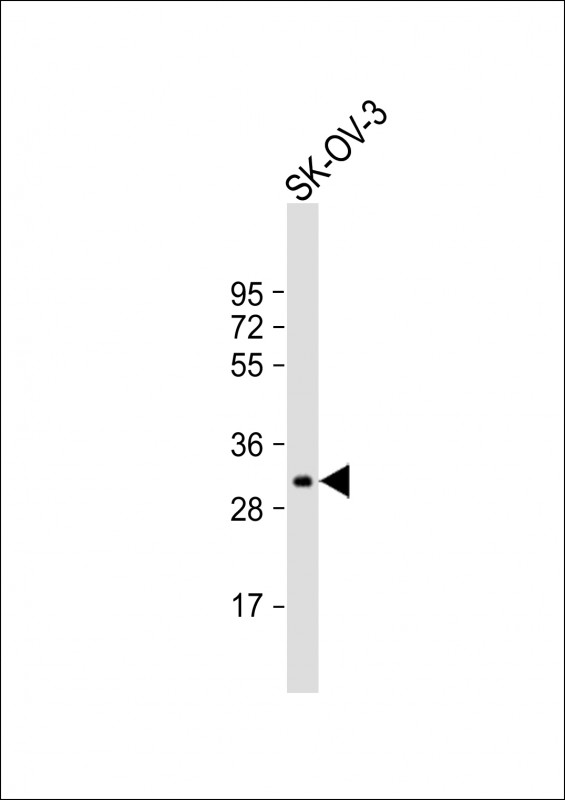
| WB | 1/2000 | Human,Mouse,Rat |
| IF | 咨询技术 | Human,Mouse,Rat |
| IHC | 咨询技术 | Human,Mouse,Rat |
| ICC | 技术咨询 | Human,Mouse,Rat |
| FCM | 咨询技术 | Human,Mouse,Rat |
| Elisa | 咨询技术 | Human,Mouse,Rat |
| Aliases | Insulin-like growth factor-binding protein 5, IBP-5, IGF-binding protein 5, IGFBP-5, IGFBP5, IBP5 |
| Entrez GeneID | 3488 |
| WB Predicted band size | 30.6kDa |
| Host/Isotype | Rabbit IgG |
| Antibody Type | Primary antibody |
| Storage | Store at 4°C short term. Aliquot and store at -20°C long term. Avoid freeze/thaw cycles. |
| Species Reactivity | Human, Mouse, Rat |
| Immunogen | This IGFBP5 antibody is generated from a rabbit immunized with a KLH conjugated synthetic peptide between 87-121 amino acids from the Central region of human IGFBP5. |
+ +
以下是关于IGFBP5抗体的3篇参考文献示例(部分内容为示例性概括,仅供参考):
---
1. **标题**:*IGFBP5 modulates osteogenesis by regulating IGF-I bioavailability*
**作者**:Mohan S, et al.
**摘要**:该研究使用IGFBP5特异性抗体,通过Western blot和免疫组化分析,发现IGFBP5通过结合IGF-I调控成骨细胞分化,抑制其过度活性,从而影响骨骼形成。抗体验证了其在骨组织中的表达模式。
2. **标题**:*IGFBP5 as a prognostic marker in breast cancer*
**作者**:Chen H, et al.
**摘要**:通过免疫组化(IGFBP5抗体)分析乳腺癌组织样本,研究发现高表达IGFBP5与患者预后不良相关,提示其可能通过促进肿瘤细胞侵袭参与转移过程。
3. **标题**:*IGFBP5 induces cellular senescence via p53-dependent pathways*
**作者**:Kimura K, et al.
**摘要**:利用IGFBP5抗体进行细胞定位和功能研究,发现IGFBP5通过激活p53通路诱导细胞衰老,抗体阻断实验进一步证实其在衰老调控中的直接作用。
---
(注:以上文献标题及作者为示例性内容,实际引用时请以真实文献为准。)
The insulin-like growth factor-binding protein 5 (IGFBP5) is a member of the IGFBP family, which regulates the bioavailability and activity of insulin-like growth factors (IGFs), particularly IGF-1. by binding to them with high affinity. IGFBP5 plays a critical role in cell growth, differentiation, and apoptosis, and is involved in tissue repair, development, and cancer progression. It exhibits both IGF-dependent and IGF-independent functions, influencing extracellular matrix interactions and modulating signaling pathways like the PI3K/AKT and MAPK cascades.
Antibodies targeting IGFBP5 are essential tools for studying its expression, localization, and function in physiological and pathological contexts. They are widely used in techniques such as Western blotting, immunohistochemistry (IHC), immunofluorescence (IF), and enzyme-linked immunosorbent assays (ELISA) to quantify IGFBP5 levels in tissues, serum, or cell cultures. Research applications include investigating its role in cancers (e.g., breast, prostate, and lung), metabolic disorders, and bone development.
IGFBP5 antibodies also hold diagnostic and therapeutic potential. Elevated or reduced IGFBP5 expression has been linked to tumor aggressiveness, metastasis, and resistance to therapies, making it a biomarker candidate. Commercially available antibodies are typically validated for specificity and cross-reactivity across species, including human, mouse, and rat. Challenges in their use may involve distinguishing between free IGFBP5 and IGF-bound forms or detecting post-translational modifications. Overall, IGFBP5 antibodies are pivotal for advancing research in endocrinology, oncology, and regenerative medicine.
×